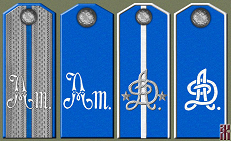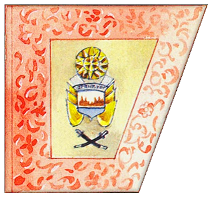
Ataman Dutov Divizion
Ataman Dutov was the political and military leader of the Orenburg Cossacks for the whole civil war period and it was quite common for a Cossack Ataman to have a unit in his name.
Ataman Dutov was the political and military leader of the Orenburg Cossacks for the whole civil war period and it was quite common for a Cossack Ataman to have a unit The unit started out as a single sotnia (squadron) but later added another sotnia or two to become a divizion (i.e. a half-regiment, not a division, regardless of what translations have).
Uniform Details
The unit wore a standard Orenburg Cossack uniform. It was likely better dressed though.
 To the left are the shoulderboards of the Ataman Dutov units as shown at kolchakiya.ru. A real life example, can also be seen there.
To the left are the shoulderboards of the Ataman Dutov units as shown at kolchakiya.ru. A real life example, can also be seen there.
The two shown on the left are a captain and trooper in the Ataman Sotnia, as it was originally. What looks like "Am" is actually an "At" in the Latin alphabet, as the Cyrillic Italic t is a rounded m shape.
The two on the right are a 2nd lieutenant and trooper in the Ataman Divizion, as it was by 1919 at least. This cipher is an "AD" standing for Ataman Dutov.
Oddly the stencilling on the troopers' is in white, and the officers' in silver, when normal Orenburg units were in yellow and gold respectively. It is also unusual to see a Cossack regiment with a piped border to the shoulderboards other than the Don, but it was a feature of guard units.
History in the RCW
In January 1919 the unit had 2 sotnias with 326 sabres and 6 MGs. It is shown on the Buzuluk Sector for the start of 1919.
There is no reason to regard it as a solely guard unit as Dutov had a separate bodyguard unit (the Don Host's "Ataman Regiment" was a front-line unit, although members did do ceremonial duty as well) .
Flags
This flag is recorded as being presented by Ataman Dutov to the Ataman Divizion on 6 May 1919 in Troitsk in the celebration of the unit's holiday (St. George the Victorious). It is a replica of one originally presented by Tsarina Catherine in 1756.
